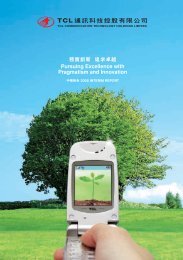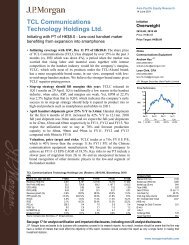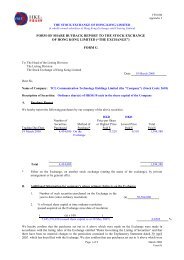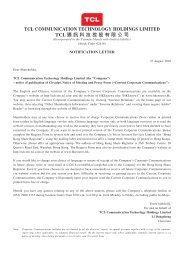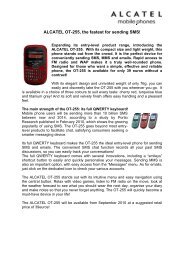2006 - TCL Communication Technology Holdings Limited
2006 - TCL Communication Technology Holdings Limited
2006 - TCL Communication Technology Holdings Limited
Create successful ePaper yourself
Turn your PDF publications into a flip-book with our unique Google optimized e-Paper software.
<strong>TCL</strong> COMMUNICATION TECHNOLOGY HOLDINGS LIMITED<br />
Notes to Financial Statements<br />
31 December <strong>2006</strong><br />
5. SUMMARY OF SIGNIFICANT ACCOUNTING POLICIES (continued)<br />
Goodwill (continued)<br />
Where goodwill forms part of a cash-generating unit (group of cash-generating units) and part of the operation<br />
within that unit is disposed of, the goodwill associated with the operation disposed of is included in the carrying<br />
amount of the operation when determining the gain or loss on disposal of the operation. Goodwill disposed of in<br />
this circumstance is measured based on the relative values of the operation disposed of and the portion of the cashgenerating<br />
unit retained.<br />
An impairment loss recognised for goodwill is not reversed in a subsequent period.<br />
Excess over the cost of business combinations<br />
Any excess of the Group’s interest in the net fair value of the acquirees’ identifiable assets, liabilities and contingent<br />
liabilities over the cost of the acquisition of subsidiaries (previously referred to as negative goodwill), after reassessment,<br />
is recognised immediately in the income statement.<br />
Impairment of non-financial assets other than goodwill<br />
Where an indication of impairment exists, or when annual impairment testing for an asset is required (other than<br />
inventories, deferred tax assets and financial assets), the asset’s recoverable amount is estimated. An asset’s recoverable<br />
amount is calculated as the higher of the asset’s or cash-generating unit’s value in use and its fair value less costs to<br />
sell, and is determined for an individual asset, unless the asset does not generate cash inflows that are largely<br />
independent of those from other assets or groups of assets, in which case, the recoverable amount is determined<br />
for the cash-generating unit to which the asset belongs.<br />
An impairment loss is recognised only if the carrying amount of an asset exceeds its recoverable amount. In<br />
assessing value in use, estimated future cash flows are discounted to their present value using a pre-tax discount<br />
rate that reflects current market assessments of the time value of money and the risks specific to the asset. An<br />
impairment loss is charged to the income statement in the period in which it arises in those expense categories<br />
consistent with the function of the impaired asset, unless the asset is carried at a revalued amount, in which case the<br />
impairment loss is accounted for in accordance with the relevant accounting policy for that revalued asset.<br />
An assessment is made at each reporting date as to whether there is any indication that previously recognised<br />
impairment losses may no longer exist or may have decreased. If such indication exists, the recoverable amount is<br />
estimated. A previously recognised impairment loss of an asset other than goodwill is reversed only if there has<br />
been a change in the estimates used to determine the recoverable amount of that asset, however not to an amount<br />
higher than the carrying amount that would have been determined (net of any depreciation/amortisation), had no<br />
impairment loss been recognised for the asset in prior years. A reversal of such impairment loss is credited to the<br />
income statement in the period in which it arises.<br />
60<br />
Annual Report <strong>2006</strong>



